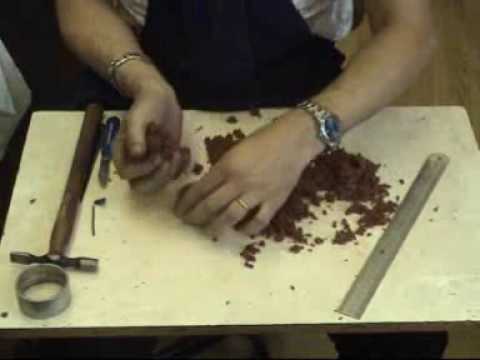Correct me if I'm wrong (my time making moulds isn't as long as 40
years), but I would think that for the ring in question the mould
lines would be on the edge of the ring, maybe a three part mould.
Because I make my moulds in sections I don't cut the original out
of the mould, so I can place the parting lines where I want them to
be.
When I make a mould from an artefact I can't afford to damage the
original.
A couple of points. First, making a mold of a wax is not the best
idea if you are making a model for production, a wax model can not be
cleaned up and polished like a metal model.
When cutting the vulcanized mold with a metal model in it (I have
only made a vulcanized silicone mold about 3 times in 40 years and I
think one or two room temperature molds) it is very important that the
cut from the object be a strait line toward the outside edge for at
least the first 1/2 inch, then do the zig zag mold locks to the
outside edge of the mold. This and proper air vents will reduce the
mold lines to barely perceivable for most pieces.
Most people do not understand how many air vents are needed to get a
clean wax model. Any recessed areas need a way for the air to escape,
and there needs to be enough cuts to allow air to escape to the
outside.
I have made a few three piece molds, but three piece molds are rare
for jewelry. Usually it is a core for a hollow piece and it is
actually a piece of rubber that is prepared with silicone spray and
talc and stuffed into the space in a coil that when vulcanized can
be pulled and removed without destroying the wax model. Think
filigree ring where the top of the ring is like an upside down bowl
and the material in the shank is cut in a spiral. Open the mold
after filling with wax, and the rubber in the center of the shank
pulls out first, the last part of the core goes up into the upside
down bowl and spirals around to the top of the inside of the bowl.
To me, mold making is an art form and as important as the wax
carving skills. After much time is spent being so accurate in the
carving, reproducing that model as accurate is important. No mold
lines and no flashing.
Why this is do important is that the clean up of a wax from a well
made mold is minimal.
And I love the process of how the mind has to approach picturing the
model in the mold and figure out what needs to be cut so the stress
of pulling the wax out of spaces does not pull the wax apart. To me
it is a form of meditation. On some items I have to meditate twice.
Richard Hart G.G.
Denver, Co.

